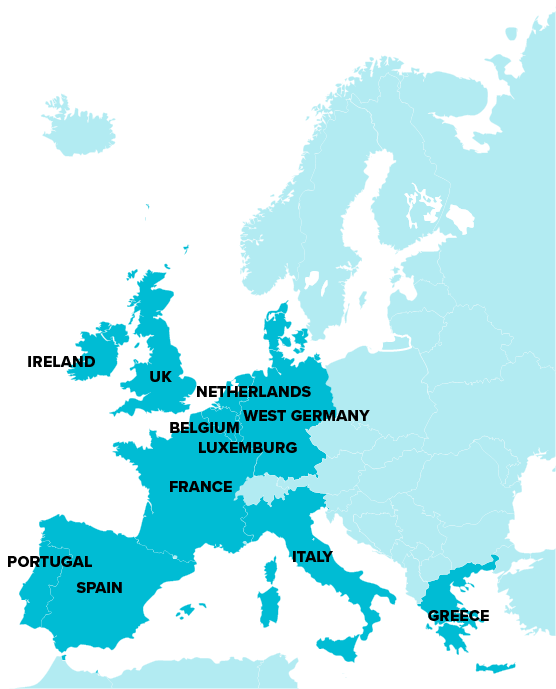OVERVIEW
01
YUGOSLAVIA: NATIONALISM UNLEASHED, EUROPE’S FIRST REFUGEE CRISIS SINCE WORLD WAR II
READ THIS PART
02
THE BIRTH OF THE EU & THE EUROPEAN ‘SUPER STATE’
Maastricht Treaty leads to the political union of member states and the birth of the European Union (EU) in 1992.
Schengen Agreement enables free movement through the abolishment of borders between 5 of the 10 EU member states in 1995.
Euro establishes a common currency between member states in 1999.
READ THIS PART
03
EUROSCEPTIC PARTIES EMERGE IN PROTEST
READ THIS PART

THE BIG PICTURE: THE MAKING AND BREAKING OF EUROPE
01
Yugoslavia: Europe’s first refugee crisis since WWII
>
More than two million people fled the former Yugoslavia's borders since the country begun to disintegrate. | PHOTO BY KAEL ALFORD/NEWSMAKERS
“The breakup of Yugoslavia was something that Europe hadn’t anticipated and Europe wasn’t ready for”
WALTER KEMP
Communism had held the multi-ethnic republic of Yugoslavia together since 1945, despite it being outside of Soviet control.
But as communist rule fell, Yugoslavia fell with it.
ARCHIVE
“The road that you are choosing for Bosnia and Herzegovina is a highway to hell. Do not think that you will not take Bosnia and Herzegovina to hell and the Muslim people into extinction. Because if there is a war, the Muslim people will not be able to defend themselves.”
Radovan Karadzic
INTERVIEW
“On the one hand it reinforced the Western images about Eastern Europe as being a powder keg of nationalism that had just been held down by communism. On the other hand that vision also kind of strengthened the idea that these countries should be integrated into the European union of peace.”
Cas Mudde
WATCH
Prior to the wars in Yugoslavia, the 1990 Charter of Paris had already drawn Eastern Bloc countries into the West’s ideological framework.
As Europe’s axis shifted, European integration was on the threshold of a historic union.
But nationalism, far from consigned to history, would threaten to pull Europe apart.
INTERVIEW
“This was the eruption of ethno-nationalist warfare on European soil.”
Dan Stone
WATCH
BACKGROUND
EUROPE'S FIRST REFUGEE CRISIS
SINCE WORLD WAR II
01
The exodus resulting from war and suffering in the former Yugoslavia presented Europe with its biggest refugee crisis since World War II.
02
Roughly 2.3 million people fled from towns and villages in the former federation of six republics since the country began to disintegrate in June 1991.
03
Of the 2.3 million refugees, more than 400,000 fled to countries outside the former Yugoslavia's borders. Germany has admitted the largest number, 200,000, followed by Hungary, with 60,000, Austria, with 50,000, and Sweden, with 44,000.
click to expand
The breakup of Yugoslavia
Refugees and displaced persons from former Yugoslavia since 1991
02
The European Super State
>
Stone memorial in front of the entry to the Limburg Province government building in Maastricht, commemorating the signing of the Maastricht Treaty | IMAGE: WIKIPEDIA, CREATIVE COMMONS 4.0
“The Maastricht Treaty was about the single currency … but was plainly leading towards the creation of a political entity in Europe, a European state, a European government.”
NORMAN LAMONT
The end days of communism had brought uncertainty and opportunity to Europe. Still coming to terms with the war in Yugoslavia that had left more than two million refugees in its wake, Western Europe pressed ahead with its most ambitious plan for greater integration.
By February 1992, the Maastricht Treaty made the 12 member states beholden to shared economic, social and security policies.
Norman Lamont
INTERVIEW
“The Maastricht Treaty was about the single currency and it set out the pathway towards the creation of the euro and the steps that had to be taken to create the euro. But Maastricht overall was plainly leading towards the creation of a political entity in Europe, a European state, a European government.”
MAASTRICHT TREATY - POLITICAL UNION
Maastricht member states

WATCH
INTERVIEW
“The Maastricht Treaty was proof for nationalists who were on the far right that the EU was really just a project of building a super national state and that transformed that completely. It also made in certain countries European integration more of a theme, which meant that there was something to talk about and the radical right had the advantage of being the only one who was critical about it.”
Cas Mudde
INTERVIEW
“There are over a dozen EU institutions, bureaucratic institutions, that most people didn't even know, mostly people and your average voter, didn't even know were being erected. You know, they didn't know that when they voted to ratify the Maastricht Treaty that you would have the emergence of this state-like bureaucracy in Brussels.”
Alina Polyakova
WATCH
THE EURO
It would also pave the way for a common currency – the euro.
On January 4, 1999, the euro is established in 11 of the 15 EU member states and begins trading at $1.1747, hitting a high of $1.1906 on the same day.
Britain, Sweden and Denmark stay out of the single currency and Greece is initially excluded because of its weak economy.
Launch of the Euro
Demos against the Euro
SCHENGEN AGREEMENT - FREE MOVEMENT
By 1995, the Schengen Area allowed people from EU member states free movement across countries.
But freedom of movement would not be freely available to all.
>
A disused customs control point in Brunehaut, Belgium. The Schengen Agreement, which led to the creation of Europe's borderless Schengen Area, was signed on 14 June 1985. | PHOTO BY CHRISTOPHER FURLONG/GETTY IMAGES
The political and economic strings of Europe were being pulled from the EU headquarters in Brussels.
The gap between governance and the governed, was getting ever greater.
INTERVIEW
“To travel you have to have funds and resources, right? If you want to take your nice holiday in Paris or southern France but maybe you live in Hungary and you don't make very much money, how are you going to take that holiday? What is the EU really getting you, right? But for those people who spoke multiple languages, who could work anywhere because they spoke English, French and German, because they had the resources, the education, they benefitted greatly from the EU.”
Alina Polyakova
INTERVIEW
“Suddenly you have all of these rules you have to follow, standards you have to meet, where maybe your family has been farming for centuries and has never changed anything and now some bureaucrat in Brussels is telling you that your farming practices are wrong and you have to invest into upgrading and that costs a lot of money. Many of the processes of EU economic and political integration were happening in sort of, now I wouldn't say the word hidden, but they were unseen by your average European.”
Alina Polyakova
WATCH
03
Eurosceptic parties emerge in protest
>
Joerg Haider, governor of the Austrian state of Carinthia and former leader of the Austrian right-wing Freedom Party. | PHOTO BY SEAN GALLUP/GETTY IMAGES
By 1999, a spate of newly established or newly invigorated populist-nationalist parties began to emerge.
The True Finns in Finland, the Sweden Democrats and the Danish People’s Party were all, to some degree, vehicles for anti-EU sentiment.
France’s National Front refocused its own nationalist manifesto against the supranational union, while in Britain, the UK Independence Party would begin to campaign to get Britain out of Europe.
But at the dawn of a new millennium, Austria had shown that after half a century of being held in check, nationalism was rising through Europe, and taking a new form.
Matthew Goodwin
INTERVIEW
“The EU imposes diplomatic sanctions on Austria and says, I’m afraid until you can prove this party endorses the values of Europe, rights for minorities and equality for all, you know, we will not be removing those sanctions.”
PROFILE
1990s
COLLAPSE OF THE SOVIET UNION
& FURTHER EUROPEAN INTEGRATION
Return to top
JÖRG HAIDER
01
Jörg Haider (1950-2008) was the long-time leader of the Austrian Freedom Party (FPÖ) and later Chairman of the Alliance for the Future of Austria (Bündnis Zukunft Österreich, BZÖ), a breakaway party from the FPÖ.
02
Several countries imposed mild diplomatic sanctions against his party's participation in government.
03
Haider died in a car accident shortly after leading the BZÖ in the 2008 Austrian Parliamentary elections.
click to expand
WATCH
ΝΕΧΤ:
2000s
FAR RIGHT GAINS A FOOTHOLD
WHILE THE EUROZONE GOES INTO CRISIS


